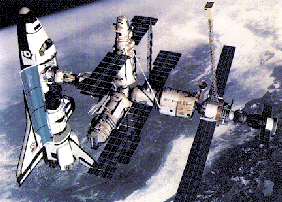|
|
Kvant

The Kvant 1 module (Kvant means 'quantum' in Russian) was
launched on 31 March 1987 and attached to the Mir space station on
12 April 1987. After that, the Mir-Kvant observatory successfully
operated until fall 1989, at which time operation was stopped for a
planned reconfiguration of the Mir station. Kvant was
"restarted" in October 1990 with calibration observations
showing no apparent degradation in performance from the year off. There
were 4 high-energy instruments in the module: TTM/COMIS - a coded mask
imaging spectrometer, HEXE - a set of 4 scintillators, GSPC - a
scintillation proportional counter, and Pulsar X-1 - a set of 4
scintillators. All 4 experiments pointed toward the same source at the
same time. These experiments, taken together, were sometimes referred to
as the RÖNTGEN Suite or Observatory.
The orbital period of the Mir station was 90 minutes. At an
inclination of 57 degrees, some 20 minutes of each orbit of each orbit
were spent outside the radiation belts. Spacecraft stabilization over a 20
minute period was better than 2 arcminutes. The Kvant module was 19
feet long and 13.6 feet across at its widest point. A cosmonaut controlled
the observations from a pressurized cabin inside the module. The mission
ended when Mir reentered the atmosphere in March 2001.
TTM/COMIS was a wide-angle camera that uses a coded aperture mask to
determine source location. It covered the energy range 2-30 keV with a 7.8
deg x 7.8 deg field of view FWHM. The geometric area was 655 cm2. It
achieved an angular resolution of 2 arcminutes and a time resolution of 1
s. The Galactic center region was imaged with the TTM demonstrating the
efficiency of coded mask telescopes observations in hard X-rays.
HEXE, or High Energy X-ray Experiment, employed a phoswich of sodium
iodide and cesium iodide. It covered the energy range 15-200 keV with a
1.6 deg x 1.6 deg field of view FWHM. Each of the 4 identical detectors
had a geometric area of 200 cm2. The maximum time resolution was 0.3-25
ms.
GSPC, also called Sirene 2, was a gas scintillation proportional
counter. It covered the energy range 2-100 keV with a 3 deg x 3 deg field
of view FWHM. The detector geometric area was 300 cm2. The instrument
had a maximum time resolution of 1.25-2.5 ms.
Pulsar X-1 consisted of 4 phoswich detectors which covered the energy
range 50-800 keV with a 3 deg x 3 deg field of view FWHM. Each of the 4
identical detectors had a 314 cm2 geometric area. The maximum time
resolution was 10 s.
[Gallery] (http://heasarc.gsfc.nasa.gov/docs/heasarc/missions/images/kvant_images.html)
[Publications] (http://heasarc.gsfc.nasa.gov/docs/heasarc/missions/biblio/kvant_biblio.html)
|
